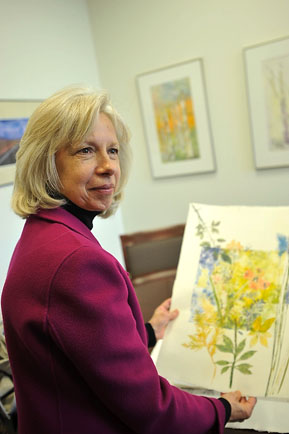The Artful Administrator
Hannelore Glaser adds color to the Provost’s Office

Thanks to the pseudo-Monets that constitute the décor in so many workplaces, institutional art has earned a bad name. The artwork that lines the hallways and suites of the Boston University Provost’s Office is a refreshing exception, consisting of vibrant and arresting pieces from current and former College of Fine Arts faculty members, including Hugh O’Donnell, Judith Simpson, and Stuart Baron (CFA’70). And there’s another artist whose work graces those walls: Hannelore Glaser, the associate provost of finance and administration.
Her title might not suggest it, but Glaser (CAS’71, GRS’77, GSM’81) is a talented painter and printmaker whose pieces combine elements of the natural world with abstract patterns of color. She specializes in monotypes, a style of printmaking that involves painting on a nonabsorbent surface and then transferring the image to paper using a printing press.
Each print can be run back through the printer multiple times if the artist wants to add or block color or press leaves or flowers on the paper’s surface, as Glaser frequently does, creating layers of texture. The process results in a unique print each time; the effects achieved in a given print can’t be confidently predicted or re-created a second time. Glaser, who describes herself as a meticulous planner, relishes the opportunities for spontaneity that the technique allows.
Some of her most striking works are a series of seasonal monotypes. To create them, she applied oil paint to an acrylic plate and then printed it onto a wet piece of watercolor paper. For a springtime series, she used vibrant, unexpected hues and petals, grasses, and leaves she’d collected near her house in New Hampshire. For a winter series, she used starker elements like twigs and wood bark, which she often painted before printing to achieve a heavier presence and a greater variety of textures. Those prints have a soft, spare palette that perfectly conveys the barrenness of a winter forest landscape.
More recently she began doing monotypes of southwestern landscapes. She and her husband, Andrew Lyasoff, a College of Arts and Sciences associate professor of mathematics and statistics and director of the Mathematical Finance Program, started vacationing in Sedona, Ariz., and she’s fallen in love with the area. “The skies are so vibrant, so blue, and the rocks are so red,” she says. Her prints, featuring deep reds and yellows, seem to glow. She uses a Q-tip or a pencil to trace an abstract landscape onto the painted plate, so the outlines of the landscape show up as white lines on the finished print.
Glaser is a rarity: a highly accomplished and happy amateur. Although she has shown a few pieces, she doesn’t sell them; she’s always painted primarily for her own pleasure. “I always had a talent for drawing,” she says, “but it was just for fun. And after I’ve painted something, when I sleep that night, I dream in color.”
Glaser has been at BU for 30 years, following a circuitous path to her present position, where she advises the deans and academic units on budget development and program growth. Her job would seem to have little in common with her artistic sensibilities, but both sides of her life rely on similar traits: an interest in planning, a love of details, and the patience to navigate a complex project.
“Of course, there are certain things that are very routine,” she adds. “Every year we’re going to have a process to develop the budget and to do salary increases. That’s the routine part. But what else is happening at the University? What are we doing, where are we growing, where are the new emphases — that’s the part that keeps it exciting.”
Bari Walsh can be reached at bawalsh@bu.edu.
Comments & Discussion
Boston University moderates comments to facilitate an informed, substantive, civil conversation. Abusive, profane, self-promotional, misleading, incoherent or off-topic comments will be rejected. Moderators are staffed during regular business hours (EST) and can only accept comments written in English. Statistics or facts must include a citation or a link to the citation.